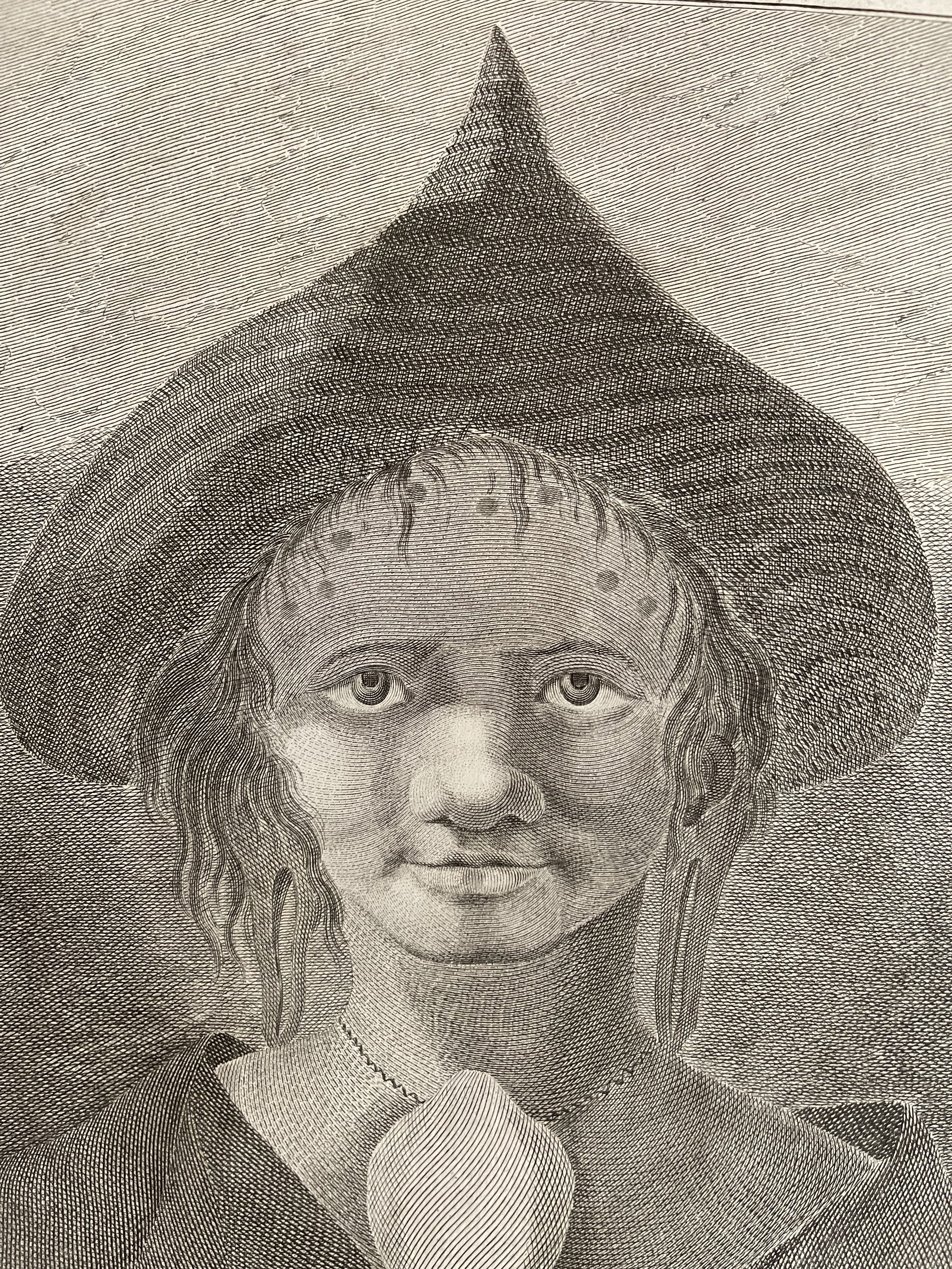Woman of Rapa Nui (Easter Island) (name unknown) - Jaques Renaud Benard - 1777-78
An early engraving of an Easter Island woman wearing a hat made of fabric and a pendant. After an original engraving by J Caldwell and illustration by William Hodges
On April 5, 1722 (Easter Day) Jakob Roggeveen arrived in sight of the island and the explorer Carl Friedrich Behrens landed there 4 days later. A tragic misunderstanding resulted in the murder of 12 natives (some acts that the Europeans took for thefts followed by a gunshot at the inhabitants); but the natives return with offerings of fruit, sugar cane and poultry. In the expedition's journal, the island is described as barren, but the population is robust and prosperous. Behrens gives some very specific elements: he is surprised by the cooking of food in the ground (Polynesian ovens), the fact that the natives wear large silver earrings (we will not find any trace of them, but Hodges' drawings during Cook's later expedition clearly represent the very elongated ears which are also those of the moai ). Behrens only observes the moai from afar and describes them as made of clay (which for him solves the problem of transportation: they are made "on site"). The expedition concluded that this island could not be the Terra Australis sought..
Many editions of the Voyage were published in London and Dublin in 1777, 1778, and in subsequent years. It is not possible to tell for which edition these plates were printed.
An early engraving of an Easter Island woman wearing a hat made of fabric and a pendant. After an original engraving by J Caldwell and illustration by William Hodges
On April 5, 1722 (Easter Day) Jakob Roggeveen arrived in sight of the island and the explorer Carl Friedrich Behrens landed there 4 days later. A tragic misunderstanding resulted in the murder of 12 natives (some acts that the Europeans took for thefts followed by a gunshot at the inhabitants); but the natives return with offerings of fruit, sugar cane and poultry. In the expedition's journal, the island is described as barren, but the population is robust and prosperous. Behrens gives some very specific elements: he is surprised by the cooking of food in the ground (Polynesian ovens), the fact that the natives wear large silver earrings (we will not find any trace of them, but Hodges' drawings during Cook's later expedition clearly represent the very elongated ears which are also those of the moai ). Behrens only observes the moai from afar and describes them as made of clay (which for him solves the problem of transportation: they are made "on site"). The expedition concluded that this island could not be the Terra Australis sought..
Many editions of the Voyage were published in London and Dublin in 1777, 1778, and in subsequent years. It is not possible to tell for which edition these plates were printed.
An early engraving of an Easter Island woman wearing a hat made of fabric and a pendant. After an original engraving by J Caldwell and illustration by William Hodges
On April 5, 1722 (Easter Day) Jakob Roggeveen arrived in sight of the island and the explorer Carl Friedrich Behrens landed there 4 days later. A tragic misunderstanding resulted in the murder of 12 natives (some acts that the Europeans took for thefts followed by a gunshot at the inhabitants); but the natives return with offerings of fruit, sugar cane and poultry. In the expedition's journal, the island is described as barren, but the population is robust and prosperous. Behrens gives some very specific elements: he is surprised by the cooking of food in the ground (Polynesian ovens), the fact that the natives wear large silver earrings (we will not find any trace of them, but Hodges' drawings during Cook's later expedition clearly represent the very elongated ears which are also those of the moai ). Behrens only observes the moai from afar and describes them as made of clay (which for him solves the problem of transportation: they are made "on site"). The expedition concluded that this island could not be the Terra Australis sought..
Many editions of the Voyage were published in London and Dublin in 1777, 1778, and in subsequent years. It is not possible to tell for which edition these plates were printed.
Code : A84
Cartographer : Cartographer / Engraver / Publisher: Jaques Renaud Direxit
Date : Publication Place / Date - 1777-7778 Approx
Size : Sheet size: Image Size: 20.9 x 27.5 cm
Availability : Available
Type - Genuine Antique
Grading - A-
Tracked postage, in casement. Please contact me for postal quotation outside of the UK.



